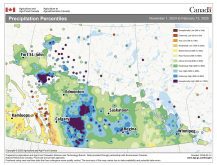Seeding is such a time of joy and hope.
It’s also a time of stress and frustration because farmers often find that weather and water prevent them from getting out into fields and getting at it.
It can also be a disappointing time because the yearly joy of seeding the crop collides with just-over-the-horizon prices that offer little more than break-even money, or losses. Another year’s work can appear to offer little more than staying in place, not making progress, but hopefully not falling into trouble.
Read Also

VIDEO: Ag in Motion documentary launches second season
The second season of the the Western Producer’s documentary series about Ag in Motion launched Oct. 8.
It seems like that sort of year now, with farmers facing poor fall and winter prices for almost all crops. This might be a year farmers work just to get through in order to get to better years in the future.
What’s shading the outlook? Generally, lacklustre prices are being negatively compounded by political disruptions to major crops. China is playing games with canola, hammering down prices and making farmers fret about movement.
Italy is jerking around the durum market, sucking away profitability from a drought-tolerant crop in a dry-soils spring.
How are farmers reacting? Statistics Canada says they have been planning to scale down canola and durum acres. It’s a big drop for durum, of almost 20 percent, but a much smaller drop for canola, down about seven percent from its maxed-out acreage of 22-23 million acres.
As I write this, it’s snowing across much of the Prairies, which will definitely delay seeding and give farmers a chance to ponder the unpromising profitability outlook.
But few will probably change plans now.
What’s a farmer to do when faced with a challenging outlook? The age-old answer is: grow his way out it.
It’s the automatic and most sensible response for the individual farmer who can’t control future prices, market access, or the weather. All he can do is do what he does best: grow the best crop possible at the lowest cost-of-production.
Last week, I pondered the unique formula that Canadian farmers will need to develop to survive and thrive in an export-oriented farming sector in an anti-trade era. With neither a big domestic market nor a supportive political structure to lend support, Canadian farmers can’t rely upon the same supports and backstops that farmers in the United States, the European Union and China count on.
Canadian farmers face much more market risk, have fewer alternatives and a weaker safety net than American and European farmers, so what can they do?
The easiest answer is to focus on producing the best crop possible at the lowest cost and hoping those out-of-my-hands factors don’t turn out to be as bad as feared.
That’s what farmers appear to be doing this year. They’re pulling back a bit from the crops that are facing the greatest dangers, but mostly they’ll stick with their rotations and hunker down for a season in which the best hope is probably for good weather and good results.
Politics, markets and prices will sort themselves out without much influence from the farmer. What the farmer can influence is the crop itself, and they’re doing that now.
The first step to surviving as an export-dependent farmer in an anti-trade age is to do a good job with the farming, and that’s what farmers appear to be doing.

















